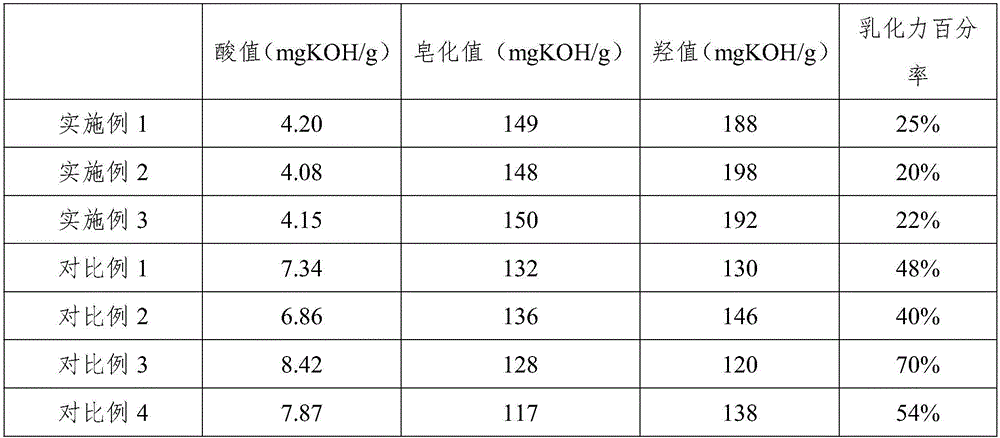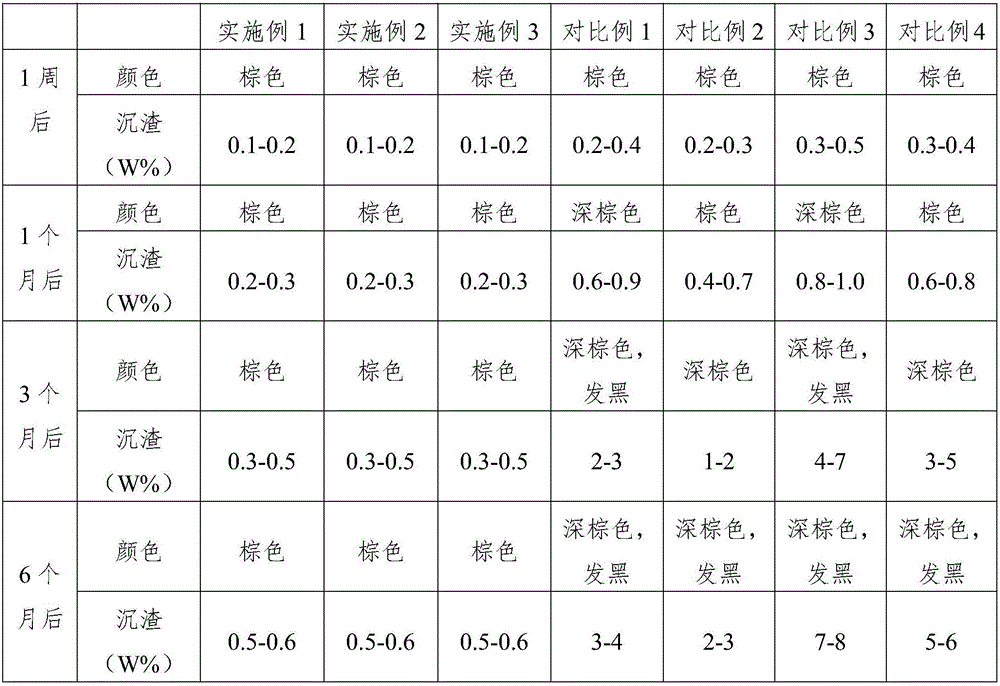Preparation method of sorbitan oleate
A technology of sorbitan oleate and oleic acid, which is applied in the field of preparation of sorbitan oleate, achieves the effects of high stability, improved performance and reduced color
- Summary
- Abstract
- Description
- Claims
- Application Information
AI Technical Summary
Problems solved by technology
Method used
Image
Examples
Embodiment 1
[0027] Embodiment 1, a kind of preparation of sorbitan oleate
[0028] S1 gets the solid sorbitol powder and places it in the reactor, raises the temperature to 90° C., stirs to a molten state, adds catalyst I, and the addition amount of the catalyst I is 4% of the solid sorbitol powder weight, and the catalyst I consists of four Butylammonium bromide and p-toluenesulfonic acid are composed of 3:2 by weight, stirred evenly, dehydrated at a temperature of 100°C and a vacuum of 0.006MPa for 2 hours, filtered, and added activated carbon when the temperature was lowered to 35°C. 50min, the addition of the activated carbon is 0.3% of the total weight of solid sorbitol powder and catalyst I, the average particle diameter of the activated carbon is 48 μm, filtered, concentrated, and dried to obtain 1,4-sorbitol;
[0029] S2 adds oleic acid and catalyst II to the 1,4-sorbitan that step S1 obtains, and the weight ratio of described 1,4-sorbitan and oleic acid is 1:1.72, the addition am...
Embodiment 2
[0030] Embodiment 2, a kind of preparation of sorbitan oleate
[0031] S1 gets the solid sorbitol powder and places it in the reactor, raises the temperature to 95° C., stirs to a molten state, adds catalyst I, and the addition amount of the catalyst I is 3% of the solid sorbitol powder weight, and the catalyst I consists of four Butylammonium bromide and p-toluenesulfonic acid are composed of 4:1 by weight, stirred evenly, dehydrated at a temperature of 105°C and a vacuum of 0.008MPa for 1 hour, filtered, and added activated carbon when the temperature was lowered to 40°C. 40min, the addition of the activated carbon is 0.4% of the total weight of solid sorbitol powder and catalyst I, the average particle diameter of the activated carbon is 50 μm, filtered, concentrated, and dried to obtain 1,4-sorbitol;
[0032]S2 adds oleic acid and catalyst II to the 1,4-sorbitan that step S1 obtains, and the weight ratio of described 1,4-sorbitan and oleic acid is 1:1.82, the addition amou...
Embodiment 3
[0033] Embodiment 3, a kind of preparation of sorbitan oleate
[0034] S1 gets the solid sorbitol powder and places it in the reactor, raises the temperature to 100° C., stirs to a molten state, adds catalyst I, and the addition amount of the catalyst I is 2% of the solid sorbitol powder weight, and the catalyst I consists of four Butylammonium bromide and p-toluenesulfonic acid are composed of 5:0.5 by weight, stirred evenly, dehydrated at a temperature of 115°C and a vacuum of 0.01MPa for 1 hour, filtered, and added activated carbon when the temperature was lowered to 45°C. 30min, the addition amount of described gac is 0.5% of the total weight of solid sorbitol powder and catalyst 1, the average particle diameter of described gac is 55 μ m, filter, concentrate, dry, obtain 1,4-sorbitol;
[0035] S2 adds oleic acid and catalyst II to the 1,4-sorbitan that step S1 obtains, and the weight ratio of described 1,4-sorbitan and oleic acid is 1:1.95, the addition amount of describe...
PUM
| Property | Measurement | Unit |
|---|---|---|
| The average particle size | aaaaa | aaaaa |
| The average particle size | aaaaa | aaaaa |
| Acid value | aaaaa | aaaaa |
Abstract
Description
Claims
Application Information
 Login to View More
Login to View More - R&D
- Intellectual Property
- Life Sciences
- Materials
- Tech Scout
- Unparalleled Data Quality
- Higher Quality Content
- 60% Fewer Hallucinations
Browse by: Latest US Patents, China's latest patents, Technical Efficacy Thesaurus, Application Domain, Technology Topic, Popular Technical Reports.
© 2025 PatSnap. All rights reserved.Legal|Privacy policy|Modern Slavery Act Transparency Statement|Sitemap|About US| Contact US: help@patsnap.com


